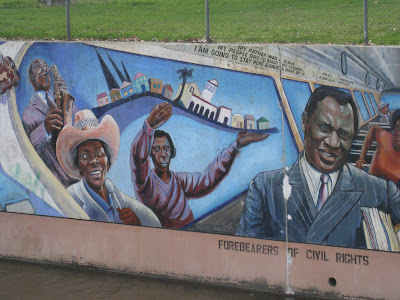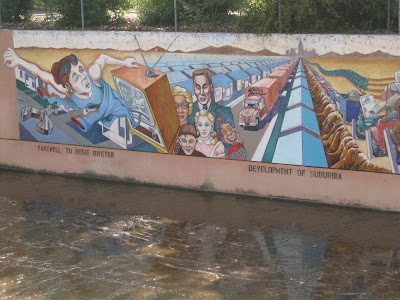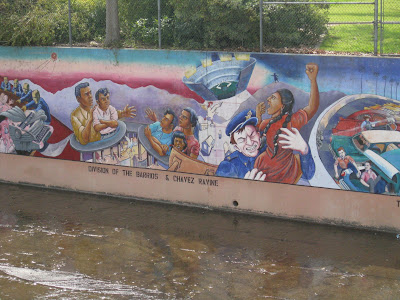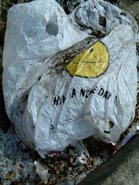 The Great Wall of Los Angeles sits almost out of sight off a suburban stretch of road in the valley. It is probable that its fading colors catch the peripheral vision of passerbyers, maybe less of those who pass it every day. When the girls and I visited the mural today, it looked in need of attention; not just a touch up -- though it was graffiti-free and not as corroded as I thought it would be -- but just of some appreciation. It seemed alone out there.
The Great Wall of Los Angeles sits almost out of sight off a suburban stretch of road in the valley. It is probable that its fading colors catch the peripheral vision of passerbyers, maybe less of those who pass it every day. When the girls and I visited the mural today, it looked in need of attention; not just a touch up -- though it was graffiti-free and not as corroded as I thought it would be -- but just of some appreciation. It seemed alone out there.Looking down the half mile of the painted flood channel that threads a lush-green pedestrian park was anti-climactic for the girls, I could see. The way I had pumped up The Wall may have warranted this reaction. Maybe they were expecting flashing lights and piped-in music; possibly a digital screen spelling out the mural's significance. I started walking along the chain link fence, telling them to come on. I explained what I knew of the different panels. I didn't know every story, but I hoped some of it, any of it, would be interesting to them. For the first 50 yards their minds wandered. I told them to pay attention. I told Mina to stop hunting for walking sticks, for Maya to slow down and take it in.

 After about ten minutes, The Wall enveloped us. Some of the stories were familiar to the girls. Some not at all. They slowly became engaged and the details of the mural started to stand out. Like the little seen image of the California lynchings, mainly of Latinos, others of Chinese and blacks, a lot done in the Los Angeles area starting in the 1850's and continuing into the 1930's.
After about ten minutes, The Wall enveloped us. Some of the stories were familiar to the girls. Some not at all. They slowly became engaged and the details of the mural started to stand out. Like the little seen image of the California lynchings, mainly of Latinos, others of Chinese and blacks, a lot done in the Los Angeles area starting in the 1850's and continuing into the 1930's.
 They are very aware of the Rosie the Riveter image. They know this symbolizes that women are capable of all things including keeping the country running as men fought in war, but The Wall's panel named Farewell to Rosie the Riveter was a sobering one because it symbolizes post WW II and how women were expected to stuff themselves and their capabilities back into a "traditional" and limited role once men were back to "handle things". After new concepts, Maya would usually only ask, "Why?"
They are very aware of the Rosie the Riveter image. They know this symbolizes that women are capable of all things including keeping the country running as men fought in war, but The Wall's panel named Farewell to Rosie the Riveter was a sobering one because it symbolizes post WW II and how women were expected to stuff themselves and their capabilities back into a "traditional" and limited role once men were back to "handle things". After new concepts, Maya would usually only ask, "Why?"  I gave Mina the camera and let her take photos how she wanted. And Maya and I talked about why oppressive history isn't told enough. She told me that she had recently learned about Pol Pot of Cambodia, but she learned of him and his massacres in English class. They have been studying poetry and her teacher introduces a lot of underrepresented stories through literature, and Maya wants to know why she doesn't learn about these things in history. Why didn't she know that Thomas Edison was Mexican, born in Mexico, adopted by white American parents?
I gave Mina the camera and let her take photos how she wanted. And Maya and I talked about why oppressive history isn't told enough. She told me that she had recently learned about Pol Pot of Cambodia, but she learned of him and his massacres in English class. They have been studying poetry and her teacher introduces a lot of underrepresented stories through literature, and Maya wants to know why she doesn't learn about these things in history. Why didn't she know that Thomas Edison was Mexican, born in Mexico, adopted by white American parents? Why would the United States refuse to take in Jewish refugees during World War II like when we turned away the thousand people on the SS St. Louis?
Why would the United States refuse to take in Jewish refugees during World War II like when we turned away the thousand people on the SS St. Louis? Why would the Los Angeles government force Latina families out of their homes in the 1950's without compensation , confiscating 300 acres of Chavez Ravine for their own projects that eventually led to freeways and Dodger Stadium?
Why would the Los Angeles government force Latina families out of their homes in the 1950's without compensation , confiscating 300 acres of Chavez Ravine for their own projects that eventually led to freeways and Dodger Stadium? The girls and I looped the park and spent over an hour looking at the mural and talking. The girls, and me too honestly, are now so used to immediate information at our fingertips -- a history of events as well as the interpretation -- that the slow-building thoughtfulness of the art and the history telling through images was impactful, and long-lasting. We left filled and contemplative. And we hope we kept The Wall company for a little while too.
The girls and I looped the park and spent over an hour looking at the mural and talking. The girls, and me too honestly, are now so used to immediate information at our fingertips -- a history of events as well as the interpretation -- that the slow-building thoughtfulness of the art and the history telling through images was impactful, and long-lasting. We left filled and contemplative. And we hope we kept The Wall company for a little while too.












15 comments:
I just learned a few things...I didn't know that Thomas Edison was Mexican from Mexico. Wasn't aware of the forced eviction of families by the government. Thank you for these arresting picture history lessons. I am glad the girls were moved by them. I agree, they need to be kept company.
Hi there,
I enjoy your writing very much and and enjoy hearing about your cycling exploits.
I do feel the need to point out that in fact Thomas Edison was born in Milan, Ohio.
Keep up the good work!
s
You're such a good mama.
There's an article in Aztlan, A Journal of Chicano Studies, called "Inquiries into Thomas Alva Edison's Alleged Mexican Ancestry." I think this is a popular legend in Mexico and I can't get the full text of the article, so I don't know what the Edison scholars say. It'd be interesting to find out.
Thanks Madame. Thanks Maven.
Hi Scott, thanks for the comment. I think this is where what is commonly recorded and what Edison's family has disputed clashes. Edison's daughter has claimed that he was born in Zacatecas, Mexico and that there is no birth record of him in the United States. Supporting Maven's comment, I will agree that where he born whether in Ohio or Mx are both theories. I tend to lead towards the familial theory. I do think anything I've written in this post can be disputed: It could be argued that the perception of women was different after WWII, though rights had been slow to follow. The lynchings of California were often private lynchings (without trial) of men who committed crimes and some of those lynched were of whites, though the disproportionate number of people of color who were killed is beyond suspicious. The California government has claimed they gave the tight-knit communities of Chavez Ravine plenty of time to sell their homes and evacuate, that the land was going to be used for more housing, that the homes and neighborhood was a "slum" anyway, worth nothing . . . The US claimed that we had reached our "quota" of Jewish refugees during WWII and there was no more room for the people on the SS St. Louis -- that was the legal policy -- causing the people to be sent back to Germany and a few other European countries. The Nazis reportedly said, You fight us to stop killing them yet you won't take them in.
Anyway, I think this is the beauty of The Wall; that another, lesser know perspective is put on the table as truth.
Thank you for these photos and the commentary to go with them. I hope that I can get by to see the wall in person - what a wonderful tribute to those who came before and a lovely way to record history.
Wow.
I hope that one day I will have the knowledge and courage to teach my daughter the history of her people as you have done with yours. I'm from a completely caucasion background, but half of my daughter's heritage is Moroccan and Spanish. She doesn't look the part at all though, seemingly getting all of genes from my side of the family...porcelain white skin, blue eyes, blond hair...
I want her to have the pride and knowledge of her heritage though as you have taught your daughters to have!
I'm so very proud of mothers like you that take those extra steps above and beyond just the "raising" of your children!
What a beautiful post and story. I sure enjoyed the gorgeous photos and words.
You are such a great mom!
Sending love, Jinxi
Thanks for you insightful reply.
I am currently making my way through a book titled "A People's History of the United States: 1492 to Present" by Howard Zinn. As a review says it "turns traditional textbook history on its head. Howard Zinn infuses the often-submerged voices of blacks, women, American Indians, war resisters, and poor laborers of all nationalities into this thorough narrative that spans American history".
The book has been enlightening and revealing. There are, indeed, other reliable sources for historical information.
s
OOoo,awesome. Thanks for the reference, Scott! I'll check that out.
Hi Dawn, thanks for the lovely comment. You'll do great. For real. If you are interested in keeping that alive for your girl, then you will. Both of those cultures are beautiful and interesting and will be fun for you to explore too. As with any culture, really. Our heritage, Puerto Rican, isn't represented on The Great Wall at all, but I just felt it important for the girls to get a look historically at what many people have had to go through in our state, our country. My mother is Irish and that too is very intersting culturally; music & dance-wise, politically, scenery, maybe not the food . . .dam, not the food. Anyway, kids usually love to learn about it all, which squashes sterotypes, makes them accepting of differences and helps them feel proud of their own story too.
Hi Jinxi & Nec & Hil - big love!
Love the wall - nice to see your pics of it.
Love Howard Zinn too.
Needless to say - lvoe to you and yours as well ---
Please post the major cross streets for the mural, either beginning or end of it.
My boyfriend and I have taken to doing self-guided tours of LA and it's surrounding cities. We've seen some awesome sights so far. Considering we're both born and raised Angelenos... We've missed a lot over the years.
Thanks for the great post!
Hi Cristina, those are the best kinds of adventures. The Wall is on Cold Water Canyon, east of the 101. The mural ends at Oxnard -- I can't remember wear it starts, but you'll see it on north side of the street. Check out the SPARC website to find their other murals around the city: http://www.sparcmurals.org/sparcone/ Let me know what you think.
Sorry, meant to post my last comment on this thread. I see others have come to the same conclusion I did re. Thomas Edison.
Great, great stuff and a reminder that taking the time to show this stuff to your girls will pay off a gazillionfold later.
I also recommend The People's History of the United States. I haven't finished it but read a chapter every now and then.
Post a Comment